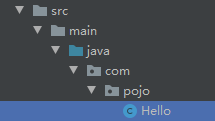先概括的说bean相关内容
| Property | Explained in… |
|---|---|
| Class | Instantiating Beans |
| Name | Naming Beans |
| Scope | Bean Scopes |
| Constructor arguments | Dependency Injection |
| Properties | Dependency Injection |
| Autowiring mode | Autowiring Collaborators |
| Lazy initialization mode | Lazy-initialized Beans |
| Initialization method | Initialization Callbacks |
| Destruction method | Destruction Callbacks |
bean可以创建很多的类型
这里假设工程结构是

bean的关键字
- id
- name
- class
- type
- value
- constructor-arg
- ref
- parent
一、构造器
无参构造
<bean id="exampleBean" class="com.pojo.Hello"></bean>
<bean name="anotherExample" class="com.pojo.Hello"/>
有参构造器
(1)根据下标顺序赋值(会模糊输入数据的类型)
<bean id="exampleBean" class="com.pojo.Hello">
<constructor-arg index="0" value="7500000"/>
<constructor-arg index="1" value="42"/>
</bean>
(2)根据类型赋值(多个构造器,若类型一致会有冲突)
<bean id="exampleBean" class="com.pojo.Hello">
<constructor-arg type="int" value="7500000"/>
<constructor-arg type="java.lang.String" value="42"/>
</bean>
(3)根据名字赋值
<bean id="exampleBean" class="com.pojo.Hello">
<constructor-arg name="years" value="2020"/>
<constructor-arg name="month" value="6"/>
</bean>
二、属性赋值
数值类型:int、short、long
字符串类型:string
布尔类型:boolean
在设置bean属性时,可以使用复合或嵌套属性名,只要路径的所有组件(最后的属性名除外)都不为空
<bean id="exampleBean" class="com.pojo.Hello">
<property name="accountDao" ref="accountDao"/>
<property name="itemDao" value="itemDao"/>
<property name="fred.bob.sammy" value="123" />
</bean>
三、数组
bean | ref | idref | list | set | map | props | value | null
<bean id="moreComplexObject" class="example.ComplexObject">
<!-- results in a setAdminEmails(java.util.Properties) call -->
<property name="adminEmails">
<props>
<prop key="administrator">[email protected]</prop>
<prop key="support">[email protected]</prop>
<prop key="development">[email protected]</prop>
</props>
</property>
<!-- results in a setSomeList(java.util.List) call -->
<property name="someList">
<list>
<value>a list element followed by a reference</value>
<ref bean="myDataSource" />
</list>
</property>
<!-- results in a setSomeMap(java.util.Map) call -->
<property name="someMap">
<map>
<entry key="an entry" value="just some string"/>
<entry key ="a ref" value-ref="myDataSource"/>
</map>
</property>
<!-- results in a setSomeSet(java.util.Set) call -->
<property name="someSet">
<set>
<value>just some string</value>
<ref bean="myDataSource" />
</set>
</property>
</bean>
四、其他操作
(1)导入其他xml文件
<beans>
<import resource="services.xml"/>
<import resource="resources/messageSource.xml"/>
<import resource="/resources/themeSource.xml"/>
<bean id="bean1" class="..."/>
<bean id="bean2" class="..."/>
</beans>
(2)别名
<alias name="已经定义的bean的名字(需要对应)" alias="自定义的别名"/>
<alias name="myApp-dataSource" alias="subsystemB-dataSource"/>
(3)命名空间
3.1 属性property
<bean name="classic" class="com.example.ExampleBean">
<property name="email" value="[email protected]"/>
</bean>
等价于
<bean name="p-namespace" class="com.example.ExampleBean"
p:email="[email protected]"/>
</beans>
3.2 构造器constructor
<bean id="beanOne" class="x.y.ThingOne">
<constructor-arg name="thingTwo" ref="beanTwo"/>
<constructor-arg name="thingThree" ref="beanThree"/>
<constructor-arg name="email" value="[email protected]"/>
</bean>
等价于
<bean id="beanOne" class="x.y.ThingOne" c:thingTwo-ref="beanTwo"
c:thingThree-ref="beanThree" c:email="[email protected]"/>
</beans>
(4)depend-on和ref
所有引用最终都是对另一个对象的引用。范围确定和验证取决于是否通过bean或父属性指定另一个对象的ID或名称。
依赖其他bean,功能类似ref。主要用于处理强依赖处理。
如用于数据库驱动程序注册。 依赖属性可以显式地强制初始化一个或多个使用该元素的bean之前的bean
<bean id="beanOne" class="ExampleBean" depends-on="manager"/>
<bean id="manager" class="ManagerBean" />
(5)懒初始化
即用的时候再实例化,比如有些数据随时可变的,防止风险
<bean id="beanOne" class="ExampleBean" depends-on="manager"/>
<bean id="manager" class="ManagerBean" />
您还可以使用元素上的default-lazy-init属性来控制容器级别的延迟初始化
<beans default-lazy-init="true">
<!-- no beans will be pre-instantiated... -->
</beans>
(6)import
<beans>
<import resource="services.xml"/>
<import resource="resources/messageSource.xml"/>
<import resource="/resources/themeSource.xml"/>
<bean id="bean1" class="..."/>
<bean id="bean2" class="..."/>
</beans>
(7)自动加载
自动装配可以大大减少指定属性或构造函数参数的需要。当代码库变得更加稳定时,自动装配可以避免切换到显式连接的选项
在使用基于xml的配置元数据(请参阅依赖项注入)时,可以使用元素的autowire属性为bean定义指定autowire模式。
| Mode | Explanation |
|---|---|
| no | |
| byName | |
| byType | |
| constructor |
五、方法
(1)工厂方法
一个工厂类也可以包含一个或多个工厂方法
5.1 一个工厂类对应一个工厂方法
<bean id="clientService"
class="examples.ClientService"
factory-method="createInstance"/>
对应的class文件
public class ClientService {
private static ClientService clientService = new ClientService();
private ClientService() {}
public static ClientService createInstance() {
return clientService;
}
}
5.2 一个工厂类对应多个工厂方法
<bean id="serviceLocator" class="examples.DefaultServiceLocator">
<!-- inject any dependencies required by this locator bean -->
</bean>
<bean id="clientService"
factory-bean="serviceLocator"
factory-method="createClientServiceInstance"/>
<bean id="accountService"
factory-bean="serviceLocator"
factory-method="createAccountServiceInstance"/>
public class DefaultServiceLocator {
private static ClientService clientService = new ClientServiceImpl();
private static AccountService accountService = new AccountServiceImpl();
public ClientService createClientServiceInstance() {
return clientService;
}
public AccountService createAccountServiceInstance() {
return accountService;
}
}
(2)destroy-method
(3)lookup-method
(4)replaced-method
(5)init-method
六、Bean作用域
| Scope | Description |
|---|---|
| singleton | |
| prototype | |
| request | |
| session | |
| application | |
| websocket |